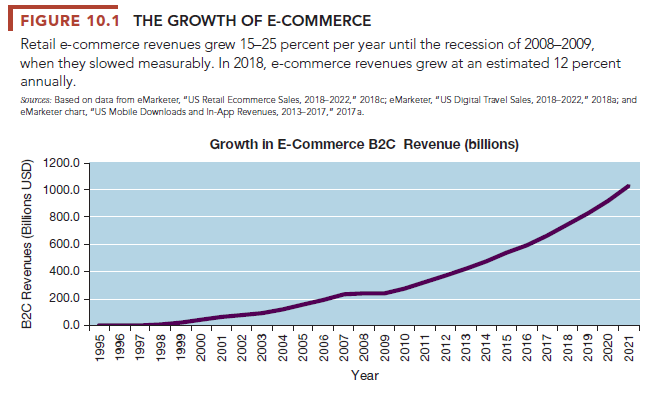E-commerce refers to the use of the Internet and the web to transact business. More formally, e-commerce is about digitally enabled commercial transactions between and among organizations and individuals. For the most part, this refers to transactions that occur over the Internet and the web. Commercial transactions involve the exchange of value (e.g., money) across organizational or individual boundaries in return for products and services.
E-commerce began in 1995 when one of the first Internet portals, Netscape.com, accepted the first ads from major corporations and popularized the idea that the web could be used as a new medium for advertising and sales. No one envisioned at the time what would turn out to be an exponential growth curve for e-commerce retail sales, which doubled and tripled in the early years. E-commerce grew at double-digit rates until the recession of 2008-2009, when growth slowed to a crawl and revenues flattened (see Figure 10.1), which is not bad considering that traditional retail sales were shrinking by 5 percent annually. Since then, offline retail sales have increased only a few percentage points a year, whereas online e-commerce has been a stellar success.
The very rapid growth in e-commerce in the early years created a market bubble in e-commerce stocks, which burst in March 2001. A large number of e-commerce companies failed during this process. Yet for many others, such as Amazon, eBay, Expedia, and Google, the results have been more positive: soaring revenues, fine-tuned business models that produce profits, and rising stock prices. By 2006, e-commerce revenues returned to solid growth and have continued to be the fastest-growing form of retail trade in the United States, Europe, and Asia.

- Online consumer sales (including travel and digital content) will grow to an estimated $830 billion in 2019, an increase of more than 12 percent over 2018 with 195 million people purchasing online and an additional 224 million shopping and gathering information but not purchasing (eMarketer, 2017b).
The Internet influences more than $2 trillion in retail commerce that takes place in physical stores, about 40 percent of all retail sales.
- The number of individuals of all ages online in the United States is expected to grow to 279 million in 2018, up from 147 million in 2004. In the world, more than 3.7 billion people are now connected to the Internet. Growth in the overall Internet population has spurred growth in e-commerce (Internet World Stats, 2018).
- Approximately 106 million U.S. households will have broadband access to the Internet in 2018, representing about 82 percent of all households.
- About 232 million Americans will access the Internet by using a smartphone in 2019. Mobile e-commerce has begun a rapid growth based on apps, ringtones, downloaded entertainment, and location-based services. Mobile e-commerce will account for about $267 billion in 2019, 44 percent of all e-commerce. Mobile phones and tablets are becoming the most common Internet access device. Currently, more than 80 percent of all mobile phone users access the Internet using their phones, although they also use their desktops (eMarketer, 2018b).
- B2B e-commerce (use of the Internet for business-to-business commerce and collaboration among business partners) expanded to more than $7.7 trillion. Table 10.1 highlights these new e-commerce developments.
Source: Laudon Kenneth C., Laudon Jane Price (2020), Management Information Systems: Managing the Digital Firm, Pearson; 16th edition.

Some really nice and utilitarian info on this internet site, as well I think the style has got fantastic features.